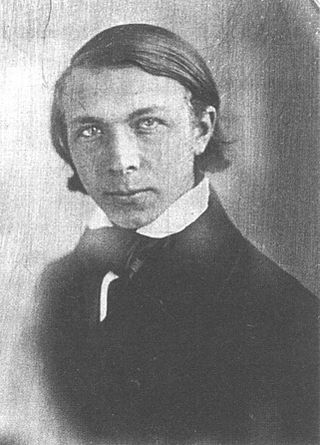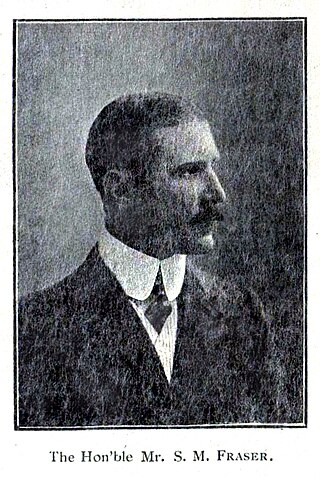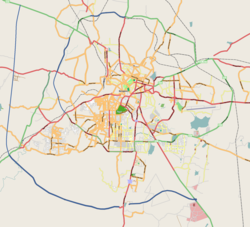
Domlur is a small township located in the eastern part of Bangalore city in India. Domlur was included in the erstwhile Bangalore Civil and Military Station under the British Madras Presidency till it was transferred to the Mysore State in 1949.

Ferdinand Kittel was a Lutheran priest and indologist with the Basel Mission in south India and worked in Mangalore, Madikeri and Dharwad in Karnataka. He is most famous for his studies of the Kannada language and for producing a Kannada-English dictionary of about 70,000 words in 1894. He also composed numerous Kannada poems.
The Bangalore Cantonment (1806–1881) was a military cantonment of the British Raj based in the Indian city of Bangalore. The cantonment covered an area of 13 square miles (34 km2), extending from the Residency on the west to Binnamangala on the east and from the Tanneries on Tannery Road in the north to AGRAM in the south. By area, it was the largest British military cantonment in South India. The British garrison stationed in the cantonment included three artillery batteries, and regiments of the cavalry, infantry, sappers, miners, mounted infantry, supply and transport corps and the Bangalore Rifle Volunteers. The Bangalore Cantonment was directly under the administration of the British Raj, while Bangalore City itself was under the jurisdiction of the Durbar of the Kingdom of Mysore.

Sir Stuart Milford Fraser, was a distinguished officer of the Foreign and Political Department of the Government of India. Five years after joining the Indian Civil Service, he was appointed tutor to the Maharajas of Kolhapur and Bhavnagar, and later (1896–1902) was tutor and guardian to the Maharaja of Mysore. The Fraser Town locality in Bangalore was named after him.

The siege of Bangalore was a siege of the town and fortifications of Bangalore during the Third Anglo-Mysore War by forces of the British East India Company, led by Charles, Earl Cornwallis against a Mysorean garrison, while Tipu Sultan, Mysore's ruler, harried the camps and positions of the besiegers. Arriving before the town on 5 February 1791, Cornwallis captured the town by assault on 7 February, and after six weeks of siege, stormed the fortress on 21 March.
Thulukhanam Shanmugham was an Indian footballer who represented his country in the 1952 Olympic Games.
Chokkanathaswamy temple, at Domlur in the Indian city of Bangalore, Karnataka, India, is dedicated to the deity known as Chokkanathaswamy or Chokka Perumal. It is one of the oldest temples in the city. The temple has numerous Kannada and Tamil inscriptions that have been documented in the Epigraphia Carnatica Vol 9, Bangalore District (1905ed). Based on these inscriptions the temple is at least as old as 1200 CE.

The Karnataka Tamils are a social community of Tamil language speakers living in Bangalore, capital city of the Indian state of Karnataka and Mysore, Mandya, Kolar Gold Fields, Chamrajnagar, and other districts of old Mysore Kingdom. According to The Hindu newspaper, Tamil-speaking settlers migrated to Bangalore in four major waves, the first after the 10th century; the second during the Vijayanagara period; and the third, in the 18th century, after the need for government service required by British East India Company who built the train tracks in Bangalore. Lastly now most Tamilians move to Bangalore for work. However some may say both Kannadiga and Tamils were there from the very beginning. According to census 1991, people speaking Tamil as mother tongue in Bangalore formed about 21%. There are 2.1 million Tamils living in Karnataka as of 2011 Census report.
Murphy Town or Knoxpete, is a suburb located near Bangalore Cantonment, India. It is one of the oldest planned suburbs of the Cantonment, and was earlier known as Knoxpete, and was later changed to Hoysala Nagar. It is located North of Halasuru, with Murphy Road running along its periphery, and is also bounded by Old Madras Road and Kensington Road, with part of Kensington Road overlooking Halasuru Lake Madras Sappers.
Fraser Town, Bengaluru or Mootocherry, is a locality of Bangalore Cantonment, located in the central part of the city spread over 4 km2. It was established in 1906 and is named after Stuart Mitford Fraser (1864–1963), who was the tutor and guardian of Krishna Raja Wadiyar IV, Maharaja of Mysore. Fraser Town was established to de-congest the growing Bangalore Civil and Military Station. The foundation of Fraser Town was laid in August 1910 by Mrs. F J Richards, with a commemorative plaque on the corner of Coles Road and Mosque Road.

Tannery Road is located in the North East of Bangalore Cantonment, India. It is a 4 km long narrow road with around 700 shops, named after the tanneries of the British India period located at the end of the Road. Tannery Road was officially renamed as Dr B S Ambedkar Road many years back, but it still is referred to by its old name. Tannery Road touches Fraser Town, Richards Town, Giddappa Block, Periyar Nagar and Pillanna Garden. The Tannery Road area is highly populated with a high density. The suburb presents a picture which is a shocking contrast to the hi-tech image of Bangalore. As elections has not brought about any changes, the residents express disillusionment with politicians and politics. Pot-holes and broken pavements are a common feature of Tannery Road, in addition to heavy traffic, water problems, garbage, etc. There is scant respect for traffic rules, and vehicles of all types zoom past in all directions. Residents have to dodge puddles of dirty water and garbage, to move around.
Cox Town, Bengaluru is a neighborhood of the Bangalore Cantonment, located in the central part of the city and named after the last Collector and District Magistrate of the Bangalore Civil and Military Station, Alexander Ranken Cox, Indian Civil Services. It is one of the suburbs which came out of the plan to de-congest thickly populated areas of the Bangalore Cantonment after the bubonic plague. Agricultural fields were converted for this purpose, and town was planned according to modern hygienic standards, with drainage and conservancy conveniences. Sarvagnanagara is bound by the Bangalore-Madras Railway line on the North and East, Wheeler Road in the East and the Ulsoor Polo Ground in the South. It consists of posh localities like Heerachand Layout and other localities like Sindhi Colony, Jeevanahalli, Doddigunta, and roads such as Assaye Road, Charles Campbell Road, Wheeler Road, etc. and is adjoining the suburbs of Pulakeshi Nagara, Sri Krishnaraja Wadiyar Nagara and Cooke Town, with easy access to the Bengaluru East Railway Station, Halasuru, Lingarajapura, Shivajinagara. Sarvagnanagara is a well planned, posh and preferred locality in the Bangalore Cantonment, created during the British Raj. The residents of Sarvagnanagara follow a liberal 'live a let live' attitude, with suburb still retaining much of its green cover, without excessive commercialisation. In 1988, the BBMP renamed Cox Town as Sarvagnanagara, after a 16th-century saint poet.
There are nearly a thousand inscriptions in Tamil in the Southern Karnataka districts of Bangalore, Mysore, Kolar and Mandya in India. Nearly one third of these inscriptions are found in the Kolar District. Of all the inscriptions collected and published in the Epigraphia Carnatica Vol X for Kolar district, a fourth are in Tamil. The Tamil inscriptions start to appear around 1000 AD, after the conquest of the region by the Chola dynasty king Rajaraja I. Even after the Cholas left the area, the Hoysala and later the Vijaynagar kingdoms continued to use Tamil in the inscriptions.

St. John's Church is located in St. John's Hill, Cleveland Town, Bangalore Cantonment, India, in between Promenade Road and St. John's Church Road. The church is the fourth oldest Protestant church in the city, with a distinct red edifice and towering steeple, rising out of the leafy surroundings. The church is dedicated to St. John the Evangelist.

The Fort Church, Bangalore, was a church located within Bangalore Fort. The church was demolished to make place for the construction of the Vani Vilas Hospital. The Government of Mysore then allotted land in Chamrajpet for construction of a new church, St. Luke's Church, Bangalore. Early records refer to the Fort Church as the Drummer's Chapel, constructed by British soldiers after the fall of Tippu Sultan. The Fort Church, Bangalore was the first protestant church to be raised in Bangalore.
Goodwill's Girls School is located at Promenade Road, Fraser Town, Bangalore Cantonment. Formerly known as the Wesleyan Tamil School, the school was renamed after Rev. Fred Goodwill, a British Missionary and Tamil scholar, who served as the manager of the school, in his capacity as superintendent of the Wesleyan Tamil Mission, Bangalore and Kolar Gold Fields.

Bengaluru East railway station, also known as Bangalore East railway station, is an old British-era railway station surrounded by Pottery Road, Kumaraswamy Naidu Road, Murgesha Mudaliar Road and Kenchappa Road. It is a small quaint station located in Fraser Town, Bangalore Cantonment. This station is very convenient for residents traveling towards or returning from Kolar Gold Fields or Madras. Express and Mail trains did not stop here until the 1920s. The station is now renovated with a larger platform. Adjacent to the railway station is the Bangalore East Football Grounds, which nowadays is more used for playing cricket. Well-known cartoonist Paul Fernandes remembers as a young boy befriending train drivers at this station and getting grease for his bicycle.
Cooke Town is a neighbourhood in Bangalore Cantonment, in Bangalore Central, India. Built as a suburb before Indian Independence, it is one of Bangalore's oldest neighbourhoods, established when the Bangalore Civil and Military Station was governed by the Madras Government. Cooke Town is named after G H Cooke, President of the Bangalore Civil and Military Station Municipality between 1928 and 1934, with the Mayo Hall being constructed during his tenure. The suburb, along with other suburbs of the Bangalore Cantonment such as Pulakeshi Nagara, Sarvagnanagara, Sir Mirza Ismail Nagara, and Langford Town, has seen dynamic changes over last few years with large British Raj era bungalows being demolished to build luxury apartments. These developments have resulted in large-scale tree-felling. However, Cooke Town still manages to retain some of its colonial charm, and is called the nicest place in the Cantonment by Bangalore historian Peter Colaco. Cooke Town is a posh neighbourhood with plenty of greenery, parks, educational institutions, hospitals and is at close proximity to the Bangalore East Railway Station in the Bangalore CBD. According to Colliers International, Cooke Town is one of Bangalore's most costliest neighbourhoods, with the cost of property being in the range to INR 80000-85000 per sq.ft, just slightly lesser than the Bangalore CBD.

Richmond Town, is a neighbourhood in central Bangalore. It is named after Thomas Richmond, a barrister in the British India government. "He was an Anglo-Indian philanthropist and the president of the All India Anglo-Indian Association.
Vira Ramanatha was a king of the southern portion of the Hoysala Empire. In 1254 CE, Hoysala king Vira Someshwara divided his kingdom between his two sons, Narasimha III who ruled from Halebidu, their original capital, had got the greater part of the ancestral kingdom and Vira Ramanatha Deva obtained the remaining part consisting of the present Kolar district and the Tamil territories conquered by the Hoysalas in the south, and ruled from Kannanur Kuppam near Srirangam. Like his father Narasimha II, Someshwara stayed back at Kannanur with Ramanatha where he was killed in 1262/1263 CE in a war with Sadayavarman Sundara Pandyan I of the Pandya dynasty.










